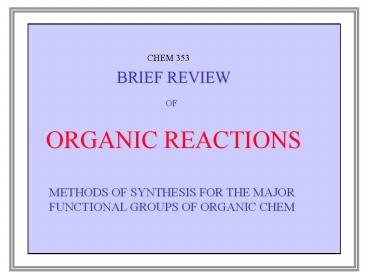ORGANIC REACTIONS - PowerPoint PPT Presentation
1 / 48
Title:
ORGANIC REACTIONS
Description:
tertiary, allylic. or benzylic. H2O. Grignard. Reaction. H3O Mg ... 3o, allylic, benzylic alcohols by SN1. the halide. is often. racemized (acid assisted) ... – PowerPoint PPT presentation
Number of Views:63
Avg rating:3.0/5.0
Title: ORGANIC REACTIONS
1
CHEM 353
BRIEF REVIEW
OF
ORGANIC REACTIONS
METHODS OF SYNTHESIS FOR THE MAJOR FUNCTIONAL
GROUPS OF ORGANIC CHEM
2
THIS SET OF SLIDES IS STILL UNDER
CONSTRUCTION.
PLEASE BE PATIENT
3
ACID HALIDES
4
SYNTHESIS OF ACID CHLORIDES
thionyl chloride
SO2
HCl
Thionyl chloride is a liquid. You can do the
reaction without a solvent or sometimes benzene
is used.
All of the other acid derivatives can be
made from the acid chloride.
5
ALCOHOLS
6
SYNTHESIS OF ALCOHOLS
H2 Ni
catalytic hydrogenation
2 atm 40o
ketone or aldehyde
low reactivity water and alcohol solvents are OK
1. NaBH4
sodium borohydride
2. H3O
reduces only aldehydes or ketones
lithium aluminum hydride
1. LiAlH4
ether solvent required
2. H3O
reduces aldehydes and ketones and many other
polar functional groups
CAUTION
7
SYNTHESIS OF ALCOHOLS - 2
gives low yields,
hydration of an alkene
oxymercuration is a better method
H2SO4
Markovnikov rule
oxymer- curation
1.
2.
Markovnikov
8
SYNTHESIS OF ALCOHOLS - 3
H2O
solvolysis of halides
tertiary, allylic or benzylic
Grignard Reaction
H3O
Mg
ether
alkyllithium compounds react just like the
Grignard
Li
Alkyllithium Compounds
ether or pentane or benzene solvent
9
SYNTHESIS OF ALCOHOLS - 4
ether
hydroboration- oxidation
3
H2O2
NaOH
H3O
3
anti-Markovnikoff
Grignard epoxide
1. RMgX / ether
2. H3O
terminal alcohols
SN2
10
Grignard oxetane
11
ALDEHYDES
12
SYNTHESIS OF ALDEHYDES
Sarrett Reagent
primary alcohol
Jones Reagent does not stop at the aldehyde
and gives a carboxylic acid.
Other oxidizing agents usually continue to the
acid RCOOH.
13
Mild Cleavage of alkenes
14
ALKENES
15
SYNTHESIS OF ALKENES
E2 elimination
heat
NaOMe
stereospecific anti
MeOH
Saytzev Rule
X Cl, Br, I
strong bases such as NaOH, NaOR required
dehydration
watch for rearrangements
H2SO4
not stereospecific
heat
acid-assisted E1 elimination
Saytzev Rule
strong acids such as H2SO4 and H3PO4 required
16
SYNTHESIS OF ALKENES - 2
catalytic hydrogenation
Lindlar
H2
cis
Lindlar Pd / BaSO4 / quinoline
syn addition
H2
wont stop
Pd
REMEMBER
2X
dissolving metal reduction
Na/NH3
trans
anti addition
17
SYNTHESIS OF ALKENES - 3
Wittig reaction
R
R
1
benzene
2
_
(C
H
)
P
(
C
H
)
P
C
R
X
R
C
X
6
5
3
6
5
3
2
1
heat
H
H
-
..
Triphenylphosphine
O-CH3
halide
..
strong base
ether
R
-
..
1
(
C
H
)
P
C
6
5
3
R
ylide
2
Wittig reagent
reaction assembles the two halves
18
ALKYNES
19
SYNTHESIS OF ACETYLENES
Acetylene from limestone
D
calcium oxide
calcium carbonate
D
calcium carbide
lime
acetylene
20
SYNTHESIS OF ACETYLENES - 2
alkylation of acetylene
elimination of dihalides
21
AMIDES
22
acid chloride or anhydride with ammonia
23
AMINES
24
ANHYDRIDES
25
SYNTHESIS OF ANHYDRIDES
acid chloride and sodium salt
-
sodium salt
Section 19.25
acid chloride
NaCl
anhydride
26
SYNTHESIS OF ANHYDRIDES - 2
dehydration of carboxylic acids
works for small symmetric anhydrides only
27
acids sulfuric acid
28
CARBOXYLIC ACIDS
29
SYNTHESIS OF CARBOXYLIC ACIDS
Jones Reagent
cannot isolate
primary alcohol
oxidation continues
Sarrett Reagent will stop at the aldehyde.
carboxylic acid
oxidation of an aldehyde
Ox
Many oxidizing agents will oxidize
aldehydes including CrO3, K2Cr2O7, KMnO4,
H2O2, Ag(NH4)OH (Tollens).
30
SYNTHESIS OF CARBOXYLIC ACIDS - 2
Grignard or R-Li CO2
1) CO2
R-MgX
R-COOH
2) H3O
1) CO2
R-COOH
R-Li
2) H3O
cleaving double and triple bonds
(oxidation)
KMnO4
KMnO4
cannot isolate
oxidation continues
Alkenes must have hydrogen on the double bond.
..
31
SYNTHESIS OF CARBOXYLIC ACIDS - 3
D
hydrolysis of a nitrile
NaCN
H2O
R-X
R-CN
R-COOH
H2SO4
acetone
NaOH
D
H2O
H3O
-
R-COO Na
hydrolysis of acid derivatives
H2O
or
or
H2O
H2SO4
or
NaOH
32
SYNTHESIS OF CARBOXYLIC ACIDS - 4
oxidation of a side chain on an aromatic ring
KMnO4
or
CrO3/H2SO4
33
EPOXIDES
34
SYNTHESIS OF EPOXIDES
peracid
cis
cis
stereospecific
via bromohydrin
cis
anti addition
stereospecific overall
cis
35
ESTERS
36
Fischer synthesis
acid chloide or anhydride alcohol
37
GLYCOLS
DIOLS
38
HALIDES
39
SYNTHESIS OF HALIDES
thionyl chloride
pyridine
inversion of configuration SN2
thionyl chloride
ether
retention of configuration
SNi
phosphorous halides
1o, 2o alcohols
inversion of configuration
SN2
40
SYNTHESIS OF HALIDES - 2
watch for rearrangements !
concentrated acids
the halide is often racemized
1o, 2o alcohols proceed by SN2 3o, allylic,
benzylic alcohols by SN1
(acid assisted)
41
SYNTHESIS OF HALIDES - 3
addition of HX to alkenes
Markovnikov rule
also HBr, HI
free radical halogenation
hn
rate 3o H gt 2o H gt 1o H
usually not a good laboratory synthetic method
chain reaction
42
KETONES
43
oxidation of alcohols
cleavage of alkenes
44
hydrolysis of imines
dont forget nitrile Grignard
dont forget organocadmium ester
45
NITRILES
46
NaCN is soluble in acetone, or DMSO could be used
SN2 displacement with cyanide
acetone
Primary or secondary halides
cyanohydrins
47
RINGS
48
CYCLOHEXENES
Diels-Alder
CYCLOPROPANES
Diazomethane
a-Eliminations
Simmons-Smith































